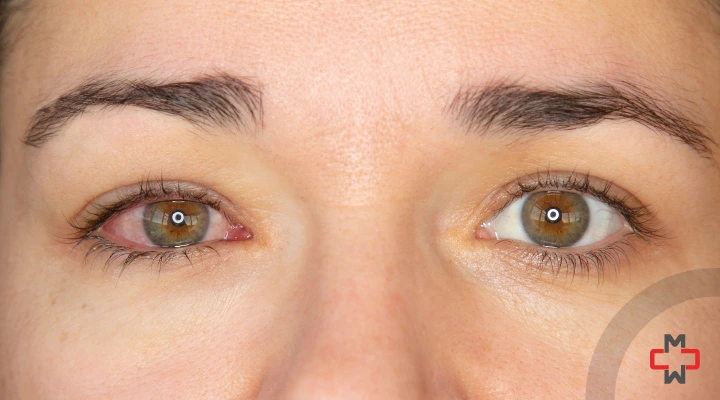Pink eye, also known as conjunctivitis, is a common eye condition that can cause discomfort and irritation. Whether you’re experiencing it firsthand or seeking information to help a loved one, understanding the duration of a pink eye is crucial for proper management and peace of mind.
In this blog by Manhattan Medical Arts, we will explore the questions that linger in the minds of those affected: “How long does pink eye last?” We will delve into pink eye symptoms, what causes it, pink eye treatment, what it looks like, if its contagious, and more.
By the end, you’ll have a comprehensive understanding of pink eye’s timeline and valuable tips to navigate through it effectively.
What Is Pink Eye (Conjunctivitis)?
Pink eye, or conjunctivitis, refers to the inflammation of the conjunctiva, the thin membrane covering the white part of the eye and the inner eyelids. It is a common eye condition caused by viral or bacterial infections, allergies, or irritants.
Symptoms include redness, itching, tearing, discharge, and a gritty feeling in the eyes. Understanding the causes and symptoms of pink eye is important for proper diagnosis and pink eye treatment.
Pink Eye Symptoms
Pink eye symptoms can vary for individuals depending on the underlying cause – However, the most commonly experienced pink eye symptoms include:
- Redness: The affected eye may appear pink or bloodshot due to the inflammation of the conjunctiva.
- Itching: The eye may feel itchy, leading to a constant urge to rub or scratch it.
- Tearing: Excessive tearing or watery discharge from the eye is a common pink eye symptom.
- Discharge: Depending on the type of conjunctivitis, there may be a discharge from the eye. It can range from watery to thick, yellow, or green in color.
- Sensation of grittiness: Some people may experience a sensation of having something gritty or sandy in their eyes.
- Swelling: The eyelids may become swollen, puffy, or droopy due to inflammation.
- Sensitivity to light: Pink eye can make the eyes more sensitive to light, causing discomfort in bright environments.
It’s important to note that pink eye symptoms may vary depending on what is the cause such as viral, bacterial, or allergic conjunctivitis. If you experience any of these symptoms, it is advised to consult with our healthcare professionals at Manhattan Medical Arts for proper diagnosis and appropriate pink eye treatment.
Pink Eye Causes
Pink eye can have various causes depending on the type of conjunctivitis.
The common pink eye causes include:
Viral Infection
Viral conjunctivitis is often caused by viruses, such as the adenovirus or herpes simplex virus. It can spread easily from person to person through direct contact with infected respiratory droplets or touching contaminated surfaces.
Bacterial Infection
Bacterial conjunctivitis is typically caused by bacteria, such as Staphylococcus aureus or Streptococcus pneumoniae. It can occur as a result of poor hygiene, contact with contaminated objects, or secondary to an upper respiratory infection.
Allergic Reaction
Allergic conjunctivitis is triggered by an allergic reaction to substances such as pollen, dust mites, pet dander, or certain chemicals. It occurs when the immune system overreacts to these allergens, leading to inflammation of the conjunctiva.
Irritants
Exposure to irritants like smoke, chemicals, or foreign substances can cause irritant conjunctivitis. These irritants can lead to redness, itching, and inflammation of the conjunctiva.
Contact Lenses
Improper use, poor hygiene, or wearing contact lenses for an extended period can increase the risk of developing conjunctivitis. Bacterial or allergic reactions can occur due to contaminated lenses or lens care solutions.
Newborns
Newborns may develop conjunctivitis due to an infection acquired during childbirth, known as neonatal conjunctivitis. It can be caused by bacteria, viruses, or other factors and requires prompt medical attention.
Understanding the pink eye cause is crucial in order to determine the appropriate pink eye treatment approach. If you suspect you have pink eye, consult with our healthcare experts at Manhattan Medical Arts for an accurate diagnosis and guidance on the most suitable pink eye treatment options.
What Does Pink Eye Look Like?
Pink eye, or conjunctivitis, is characterized by distinct visual signs. When affected by pink eye, the normally white part of the eye takes on a light pink to a reddish hue, while the eyelids may appear swollen or droopy.
It is not uncommon to observe fluid discharge from the infected eye, and there may be crusty formations on the eyelashes and eyelids. These visible indications help identify the presence of pink eye and differentiate it from other eye conditions.
Is Pink Eye Contagious?
Yes, pink eye, also known as conjunctivitis, can be contagious. It can easily spread through direct contact with infected eye secretions or respiratory droplets. The contagiousness varies depending on whether it is viral or bacterial conjunctivitis. Good hygiene practices, such as frequent handwashing and avoiding touching the eyes, can help prevent the spread of pink eye.
How Long Does Pink Eye Last?
The duration of pink eye varies depending on the cause. Viral pink eye usually lasts about 1 to 2 weeks, while bacterial pink eye can clear up within 1 to 2 weeks with pink eye treatment. Whereas, allergic pink eye can last as long as the person is exposed to the allergen. If symptoms persist, visit Manhattan Medical Arts for appropriate guidance.
Pink Eye Treatment
Pink eye treatment depends on the underlying cause:
Viral Conjunctivitis
Since a virus causes viral pink eye, antibiotics are not effective. Treatment typically involves symptom management, such as applying warm compresses to the eyes, using artificial tears for lubrication, and practicing good hygiene to prevent the spread of infection. Most cases of viral conjunctivitis resolve on their own within 1 to 2 weeks.
Bacterial Conjunctivitis
Bacterial pink eye is often treated with antibiotic eye drops or ointments. These medications help eliminate the bacteria causing the infection. It is important to complete the full course of antibiotics as prescribed by a healthcare professional to ensure complete recovery and prevent recurrence.
Allergic Conjunctivitis
Treatment for allergic pink eye involves identifying and avoiding allergen triggers. Over-the-counter antihistamine eye drops or oral antihistamines may be recommended to alleviate pink eye symptoms. Sometimes, a doctor may prescribe stronger medications or recommend allergy shots for long-term management.
It is essential to consult healthcare professionals for an accurate diagnosis and treatment, for personalized recommendations based on the specific type and severity of pink eye. Additionally, practicing good hygiene, such as washing hands regularly and avoiding touching the eyes, can help prevent the spread of pink eye, regardless of the pink eye causes.
Conclusion
In conclusion, pink eye can be a bothersome condition, but with proper understanding and timely intervention, it can be effectively managed. Whether it is viral, bacterial, or allergic in nature, seeking medical advice for an accurate diagnosis is crucial. By following the recommended pink eye treatments and practicing good hygiene, its duration can be minimized, and pink eye symptoms can be alleviated.
Remember, if you experience persistent or worsening pink eye symptoms, it is always wise to consult with our experienced preventative care physicians at Manhattan Medical Arts, who can provide further guidance and ensure your eye health is protected.
Stay informed, take necessary precautions, and prioritize your eye care to maintain healthy and clear vision.
Disclaimer
This blog is for informational & educational purposes only, and does not intend to substitute any professional medical advice or consultation. For any health related concerns, please consult with your physician, or call 911.
-
About The Author
Dr. Syra Hanif M.D.Board Certified Primary Care Physician
Dr. Syra Hanif is a board-certified Primary Care Physician (PCP) dedicated to providing compassionate, patient-centered healthcare.
Read More







